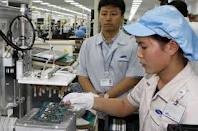INDOCHINA INTERNATIONAL CONSULTING CO., LTD
HO Add: 62L/36 Nguyên Hồng, Ward 11, Bình Thạnh District, HCMC - Vietnam
Biz Office Add: #48 Road No 11, Quarter 6, Hiệp Binh Chánh Ward, Thủ Đức, HCMC - Vietnam
®Source: http://viipip.com should be clearly quoted for any use of information extracted from our website.
Publication permit No: 60/GP-TTĐT , April 05, 2010.


Shim Won Hwan, general director of Samsung Electronics Vietnam (SEV) said the South Korean firm had to make a final decision on expanding investment to $1.5 billion in Bac Ninh province, where it already has a $670 mobile phone factory.
"We are excited to expand investment in Vietnam, but we want to be sure that the expansion will enjoy tax incentives like a newly established project,” said Hwan.
"Without incentives, our products will lose to other rivals. We are wavering,” he said.
The Vietnamese government last year recognised Samsung Electronics Vietnam as a hi-tech firm, allowing the manufacturer to enjoy highest incentives with a 10 per cent corporate income tax rate for all products manufactured at its Bac Ninh factory.
However, the jury is out on whether this rate will also cover products produced by expansion facilities.
A Ministry of Planning and Investment (MPI) source said under the Enterprise Law, investment expansion will not be granted incentives like a newly established project.
Early this year, the government has assigned the MPI, Bac Ninh People’s Committee and other related ministries to study the possibility of giving incentives for Samsung’s expansion. The MPI source said the government would further discuss this issue.
"I know the government supports Samsung project and will find a way to solve this obstacle,” said the source.
Vietnam is among Samsung’s largest manufacturing bases. The Bac Ninh factory produces latest Samsung hi-tech products, serving the Asian and European markets. Samsung expects it will reach $16 billion in export revenue by 2015 in Vietnam.
From 2008 to early 2012, 32 foreign-backed companies announced to invest $450 million in Vietnam to provide components for Samsung’s products. By 2015, Samsung could need 96 foreign component providers and a similar number of local suppliers.
- FDI capital continues to pour into Vietnam (6/11/2025 1:20:33 PM)
- Thanh Hoa receives good news: Preparing to have an additional industrial park of up to 470 hectares, creating jobs for nearly 30,000 people (6/11/2025 1:15:09 PM)
- Industrial Park Real Estate: Waiting for the New Generation of FDI (6/11/2025 1:10:15 PM)
- A wealthy Vietnamese city will have two special economic zones after the merger (6/11/2025 1:04:42 PM)
- 30 billion USD capital FDI in Việt Nam by 2025, a series of "ông big" races to expand the land fund (6/11/2025 12:55:26 PM)
- the 2nd largest city in the North will start construction on an international economic zone (6/11/2025 12:50:20 PM)
- Japanese giant Sumitomo continues to want to build an industrial park in the countrys fourth smallest province. (6/11/2025 12:40:45 PM)
- 3 foreign corporations want to invest billions of dollars in Ba Ria - Vung Tau (6/11/2025 12:34:30 PM)
- Lotte Group member starts construction of nearly 1,000 billion VND logistics center in the province with the most industrial parks in Vietnam (6/11/2025 12:33:26 PM)
- Forming a regional center for manufacturing spare parts and components (6/11/2025 12:24:08 PM)
- Vietnams first wafer factory is about to start construction (6/11/2025 12:19:09 PM)
- Dong Nai attracts foreign investors (6/11/2025 12:13:27 PM)
- Tay Ninhs largest industrial park welcomes a $150 million high-end knitted fabric factory project (6/11/2025 12:11:00 PM)
- (6/11/2025 12:09:10 PM)
- Vietnam will become a destination for Chinese investors in the future (11/6/2023 1:03:19 PM)

- FDI capital continues to pour into Vietnam
- Thanh Hoa receives good news: Preparing to have an additional industrial park of up to 470 hectares, creating jobs for nearly 30,000 people
- Industrial Park Real Estate: Waiting for the New Generation of FDI
- A wealthy Vietnamese city will have two special economic zones after the merger
- 30 billion USD capital FDI in Việt Nam by 2025, a series of "ông big" races to expand the land fund










 ADB: Vietnam’s 2009 GDP growth to be highest in South East Asia
ADB: Vietnam’s 2009 GDP growth to be highest in South East Asia MGM Grand Ho Tram: Vietnam’s First ‘Las Vegas Style’ Integrated Resort
MGM Grand Ho Tram: Vietnam’s First ‘Las Vegas Style’ Integrated Resort Nha Trang’s Twin Towers project licenced
Nha Trang’s Twin Towers project licenced Foreign investors still have good opportunities in Vietnam
Foreign investors still have good opportunities in Vietnam Sierra Wireless gets a foot in Vietnam’s ICT market
Sierra Wireless gets a foot in Vietnam’s ICT market